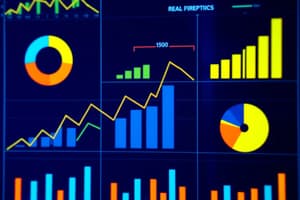Podcast
Questions and Answers
What is the primary focus of predictive analytics?
What is the primary focus of predictive analytics?
- Summarizing historical data trends
- Identifying relationships between variables
- Determining probable future outcomes (correct)
- Understanding why past events occurred
Which technique is commonly used in diagnostic analytics?
Which technique is commonly used in diagnostic analytics?
- Natural Language Processing
- Regression Analysis (correct)
- Sentiment Analysis
- A/B Testing
Which statement best describes the difference between descriptive analytics and diagnostic analytics?
Which statement best describes the difference between descriptive analytics and diagnostic analytics?
- Descriptive analytics summarizes past data, while diagnostic analytics explains why events happened. (correct)
- Descriptive analytics uses machine learning, whereas diagnostic analytics uses statistical algorithms.
- Descriptive analytics helps in data visualization, while diagnostic analytics focuses on data preparation.
- Descriptive analytics focuses on future predictions, while diagnostic analytics addresses past events.
Which of the following is NOT associated with the practice of predictive analytics?
Which of the following is NOT associated with the practice of predictive analytics?
What role do machine learning models play in predictive analytics?
What role do machine learning models play in predictive analytics?
In which field is predictive analytics applied to understand patient outcomes?
In which field is predictive analytics applied to understand patient outcomes?
Which of the following is NOT a technique used in diagnostic analytics?
Which of the following is NOT a technique used in diagnostic analytics?
What is primarily assessed in predictive analytics related to marketing?
What is primarily assessed in predictive analytics related to marketing?
What is the primary goal of prescriptive analytics?
What is the primary goal of prescriptive analytics?
Which type of data analytics is primarily used to analyze past data and derive insights?
Which type of data analytics is primarily used to analyze past data and derive insights?
How do data analysts contribute to problem-solving in a business?
How do data analysts contribute to problem-solving in a business?
What distinguishes predictive analytics from descriptive analytics?
What distinguishes predictive analytics from descriptive analytics?
Which of the following is NOT a benefit of using data analytics in business?
Which of the following is NOT a benefit of using data analytics in business?
Which statement about data specialists is incorrect?
Which statement about data specialists is incorrect?
What is an essential outcome of implementing data analytics?
What is an essential outcome of implementing data analytics?
Which phase typically follows the data collection in the data analysis process?
Which phase typically follows the data collection in the data analysis process?
What is the primary focus of data analysis?
What is the primary focus of data analysis?
Which type of data analytics aims to identify relationships and trends from historical data?
Which type of data analytics aims to identify relationships and trends from historical data?
Which type of data analytics is concerned with forecasting future outcomes?
Which type of data analytics is concerned with forecasting future outcomes?
What distinguishes data analytics from data analysis?
What distinguishes data analytics from data analysis?
Which of the following is NOT a type of data analytics?
Which of the following is NOT a type of data analytics?
What is an example of descriptive analytics?
What is an example of descriptive analytics?
Which approach would be best to use for optimizing a business process?
Which approach would be best to use for optimizing a business process?
In data analysis, what is the aim of diagnostic analytics?
In data analysis, what is the aim of diagnostic analytics?
Flashcards are hidden until you start studying
Study Notes
Diagnostic Analytics
- Answers "Why did it happen?" by identifying causes of past events.
- Helps organizations understand relationships between different variables.
- Key techniques include Data Discovery, Data Mining, and Correlations.
- Advanced methods like Regression and Time Series Analysis are often used.
- Machine Learning Models assist in uncovering complex patterns from large datasets.
Predictive Analytics
- Focuses on future possibilities and outcomes, answering "What could happen?"
- Utilizes historical data through statistical algorithms and machine learning.
- Applications include sales forecasting, credit scoring, and predicting customer behavior.
- Emphasizes proactive decision-making based on potential future scenarios.
- Commonly implemented using programming languages like Python or R.
Prescriptive Analytics
- Recommends specific actions to achieve desired outcomes (e.g., optimizing supply chains).
- Combines insights from Descriptive and Predictive analytics to guide decisions.
Importance of Data Analytics
- Reduces inefficiencies and streamlines operations across various sectors.
- Drives revenue growth by providing actionable insights.
- Enhances decision-making by offering data-driven recommendations.
- Lowers operational expenses through improved processes.
- Improves customer experiences and satisfaction.
Data Analytics Roles
- Data Analysts: Identify key insights from data, communicate findings, and solve organizational problems.
- Data Scientists: Combine statistical and programming skills with industry knowledge to derive insights and drive results.
- Business Analysts: Assess organizational performance and facilitate improvements in processes and systems.
Data Analysis vs. Data Analytics
- Data Analysis: Focuses on historical data to understand past events and performance.
- Data Analytics: Aims to predict future events and trends, facilitating forward-looking strategies.
Types of Data Analytics
-
Descriptive Analytics: Simplest form, summarizes historical data to identify trends and relationships without deeper exploration.
- Example: Hospitals analyzing patient records to track trends such as average wait times and diagnoses.
-
Diagnostic Analytics: Analyzes past events to derive reasons for outcomes.
-
Predictive Analytics: Projects future events based on statistical and machine learning techniques.
-
Prescriptive Analytics: Provides recommendations for specific actions based on data analysis.
Studying That Suits You
Use AI to generate personalized quizzes and flashcards to suit your learning preferences.




